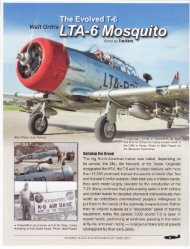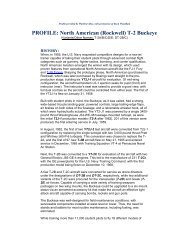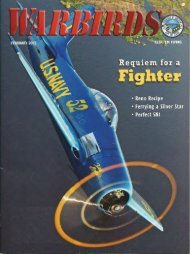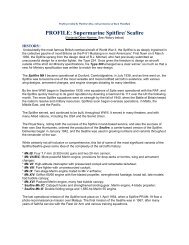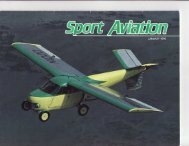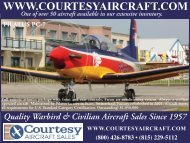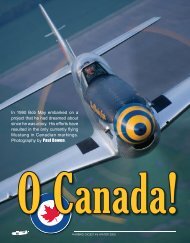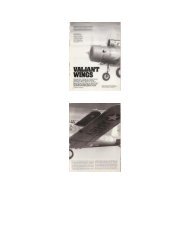Warhawk Inc.'s Fabulous P-40 Restoration - Courtesy Aircraft
Warhawk Inc.'s Fabulous P-40 Restoration - Courtesy Aircraft
Warhawk Inc.'s Fabulous P-40 Restoration - Courtesy Aircraft
Create successful ePaper yourself
Turn your PDF publications into a flip-book with our unique Google optimized e-Paper software.
Aleutian<br />
TIGER!<br />
TIGER!<br />
<strong>Warhawk</strong> <strong>Inc</strong>.’s <strong>Fabulous</strong> P-<strong>40</strong> <strong>Restoration</strong><br />
The northern part of the United States has started to gain a reputation as a<br />
hot bed of warbird restoration activity. For many years two small towns in North<br />
Dakota, Kindred and Wahpeton, have been synonmous with quality P-51 Mustang<br />
restorations by Odegaard Aviation and Tri-State Aviation respectively. Now the<br />
small town of Granite Falls, Minnesota, within a stones throw of North Dakota,<br />
can boast of the finest in P-<strong>40</strong> <strong>Warhawk</strong> restorations. Ron Fagen’s <strong>Warhawk</strong>s <strong>Inc</strong>.<br />
has recently completed the first of a series of Curtiss P-<strong>40</strong> restorations that are<br />
sure to turn some heads. The folks at <strong>Warhawk</strong>s <strong>Inc</strong>. were kind enough to allow<br />
Warbird Digest to visit and see their impressive new operation while Greg Morehead<br />
photographed their stunning first project.<br />
14 WARBIRD DIGEST #10 SEPTEMBER/OCTOBER 2006
WARBIRD DIGEST #10 SEPTEMBER/OCTOBER 2006<br />
5Three generations of aviation enthusiasts. Ron Fagen with his<br />
father Ray Fagen and grandson Ethan Fagen.<br />
3The team responsible for the restoration. (left) Jason Dunn<br />
Fagen <strong>Inc</strong>. corporate mechanic, (middle) Erik Hokuf with Sparky<br />
(right) Brandon Deuel, <strong>Warhawk</strong>s <strong>Inc</strong>. machinist.<br />
15
5(top) As evidenced by these recovery photographs, the P-<strong>40</strong>K<br />
was rather heavily vandalized over the nearly fifty years since<br />
its forced landing. The incredible efforts necessary to return the<br />
<strong>Warhawk</strong> to the air are clear.<br />
5(middle) The completed fuselage and wing section are mated<br />
together on the ramp at Granite Falls.<br />
16 WARBIRD DIGEST #10 SEPTEMBER/OCTOBER 2006<br />
Ron Fagen didn’t set out to own an operation specializing<br />
in Curtiss fighters; in fact, he had long had his eyes set on<br />
fighters from other manufacturers altogether. “Shortly after I<br />
got married in the mid-seventies, I decided I wanted to own a<br />
Mustang or a Corsair. Well, I gathered up a couple of buddies<br />
of mine and we decided to head for Central America to buy<br />
one. In my naiveté, I planned to fly down there, locate one<br />
,jump in it and fly it home. A couple of us jumped in a Mooney<br />
and headed for El Salvador. We missed the Corsairs by just<br />
a few months, so we headed on over to Guatemala City to<br />
look for P-51s. I found one chained to a tree that Guatemalan<br />
military personnel were running up every once in a while.<br />
Since I was in the construction business, I offered to build the<br />
local commander a hangar in exchange for the airplane, but he<br />
declined since they wanted to keep the airplane as a memorial.<br />
So we returned empty-handed. In retrospect it was probably a<br />
good thing because I would have likely killed myself trying to<br />
fly it home. I wouldn’t have been the first to do so.”<br />
With his hopes of buying a cheap warbird fighter dashed,<br />
Fagen entered into the world of competition aerobatics and<br />
for the next ten years spent his time building his business<br />
and honing his flying skills. In 1985 Fagen stopped his<br />
participation in competition aerobatics, but continued to<br />
fly while he focused on his business. Over the years his<br />
company became the world leader in the development and<br />
construction of ethanol plants. While preoccupied with other<br />
matters, the desire for a warbird was still resident in Fagen.<br />
In the early nineties he decided to visit Stallion 51 for some<br />
Mustang training. “I went down to see Lee Lauderback to fly<br />
the Mustang. I had a lot of Pitts time, but the Mustang was a<br />
different animal. Anyone who thinks they can just jump from<br />
a Pitts into a Mustang without the proper training is asking<br />
for trouble. My time at Stallion 51 reinforced that I would<br />
have had a difficult time had I tried to bring home a fighter<br />
from Central American.”<br />
When Fagen came home from flying ‘Crazy Horse’ in<br />
Florida, he was even more passionate about warbirds and<br />
in particular the P-51. “I came home, and I really wanted<br />
a Mustang, but I couldn’t afford one at the time. Shortly<br />
after I got back, John Sandberg was killed over in Pierre,<br />
South Dakota in his air racer, Tsunami. I was aware of his<br />
Mustang, ‘Platinum Plus’ which had been totally rebuilt, and<br />
I decided to see if the family was going to sell it. After a bit I<br />
called Sharon Sandberg and asked if they were interested in<br />
selling the airplane. They told me they thought they would<br />
like to keep it. Some period of time went by and they called<br />
me back and said they were considering selling it. I went to<br />
Minneapolis and met with Sharon and Sam Torvik and we<br />
worked out a deal. At the time the airplane had a real ‘hot’<br />
racing engine in it and they wanted to keep it, so they offered<br />
to overhaul a brand new Merlin that was still in the shipping<br />
crate. I agreed and returned home to visit with my banker.<br />
He was agreeable to loaning me the money, so I owned a<br />
Mustang. A few months later the engine was done and we<br />
went up to Salt Lake City where the airplane had been sitting<br />
in Gary Levitz’ hangar. We swapped the engine and then Skip
Holm came in to test fly it and deliver it to Granite Falls.<br />
When Skip brought it to Granite Falls he beat up our little<br />
grass strip pretty good and then landed. Torvik convinced<br />
him to take me around the patch for my first flight in my<br />
own Mustang. After they left I went out and flew it. It had<br />
been a bit since I had been to Stallion so I went over the<br />
books pretty well, but it was a dream come true.”<br />
With the long sought after Mustang in the fold, Fagen<br />
thought he was finished buying warbirds for a while. “On<br />
Thanksgiving I was at my dad’s house reading Trade-<br />
A-Plane when I stumbled across an advertisement for a<br />
P-<strong>40</strong>E for an unbelievable price. Not only was the price<br />
unbelievable, but it was not too far from me in Carmen,<br />
Manitoba. We quickly ate our Thanksgiving meal and my<br />
father and I jumped in my Bonanza and headed up there.<br />
Now, I had never seen a P-<strong>40</strong> before, but I just knew this<br />
had to be a good deal. We met Bob Diemert there at his<br />
farm/airport and looked over the P-<strong>40</strong>. In the advertisement<br />
he claimed it was a P-<strong>40</strong>E but when we got there he told<br />
us it was a P-<strong>40</strong>F, because it was a Merlin engine model.<br />
Now remember, I didn’t know much about P-<strong>40</strong>s, but it sure<br />
looked like it was all there. So I made the deal, for just a<br />
little shy of $300,000. Diemert told me it would take some<br />
time to get all the paperwork sorted out with the Canadian<br />
authorities, and I flew home thinking I had just made the<br />
deal of the century. A couple of days later I was talking to<br />
Gerry Beck and I mentioned this P-<strong>40</strong>. He stopped me and<br />
said, ‘You didn’t buy that, did you?’ I told him I had, and<br />
(top & bottom) The P-<strong>40</strong>K in the clean and well-organized hangar<br />
where Hokuf performed the restoration. <strong>Warhawk</strong>s <strong>Inc</strong>. has now<br />
moved into more spacious and well equipped facilities and this<br />
hangar will become the sheet metal shop for the company.<br />
WARBIRD DIGEST #10 SEPTEMBER/OCTOBER 2006<br />
17
18 WARBIRD DIGEST #10 SEPTEMBER/OCTOBER 2006<br />
he told me that everyone, including himself, had been up there<br />
looking at this airplane chasing the elusive ‘deal of the century’ P-<br />
<strong>40</strong>, but that it really wasn’t a true P-<strong>40</strong>. Now I was getting a little<br />
nervous, so I gathered up as much data on the P-<strong>40</strong> as I could and<br />
went up and looked at it again. It had a real P-<strong>40</strong> wing. It had been<br />
spliced in a couple of places, but it was the right dimensions and<br />
had the right profile. The fuselage was pretty cobbled up and it<br />
had a T-6 Texan tail. The engine, of course, was supposed to be an<br />
Allison, as it really was an E-model. After looking it over, I began<br />
to feel a little bit better. After all, a considerable amount of the<br />
airplane was real P-<strong>40</strong>. I had already paid for the airplane, so I was<br />
committed and I was pleased to find that I hadn’t done too badly.<br />
Fagen sent the fuselage to Tom Wilson of Griffin, Georgia,<br />
who at the time was heavily engaged in the rebuild of P-<strong>40</strong><br />
airframes. When the fuselage was complete, it was mated back<br />
to the existing wing. The P-<strong>40</strong>E, actually a RCAF Kittyhawk I,<br />
AK753 N4420K was painted as the mount of ace Ray Calloway<br />
as ‘Shirley III.’ Calloway was a Granite Falls hero having gone<br />
off to the CBI to join Claire Chennault’s Chinese-American<br />
Composite Wing and returned a 6.5 victory ace.<br />
While Fagen was struggling to straighten out the bugs in AK753<br />
several states away in Tipton, Kansas, Ken Hake was quietly<br />
working on another P-<strong>40</strong> project. One of two P-<strong>40</strong>s he acquired<br />
from Russia in 1991, USAAF Serial No. 42-10256 was a Lend<br />
Lease aircraft that made its way to the Soviet Union in November<br />
1942, most likely by flying through Canada, across the Aleutian<br />
Islands, through Siberia to the western front. In September 1943<br />
the pilot, JLt I.I. Mikhajlov became disorientated after combat<br />
with four Messerschmitts of JG 5 and crashed in Murmansk on<br />
the Kola Peninsula, near Scandinavia. Walter Zaag of Switzerland
5(top left) The Curtiss specifications<br />
call for the gun barrels to be sealed with<br />
Minnesota Mining and Manufacturing<br />
scotch-type tape. Minnesota Mining is now<br />
known as 3M.<br />
5(top middle) The P-<strong>40</strong>K left the factory with<br />
bomb racks on the outer wing panels which<br />
were designed to carry small anti-personnel<br />
or fragmentation bombs. This is likely the first<br />
restoration to have this detail added.<br />
3The landing gear of the P-<strong>40</strong> was cadmium<br />
plated, not painted.<br />
4The interior of the aft fuselage and the radio<br />
racks. The original radios have been obtained,<br />
but had not yet been installed when Warbird<br />
Digest visited. The zinc chromate color is the<br />
original shade per the Berryloid specifications.<br />
The factory drawings call for the flap<br />
bays to be left zinc chromate.<br />
WARBIRD DIGEST #10 SEPTEMBER/OCTOBER 2006<br />
The highly detailed gun bays of<br />
the P-<strong>40</strong>. Over 150 individual<br />
components were required for<br />
each bay.<br />
19
20 WARBIRD DIGEST #10 SEPTEMBER/OCTOBER 2006<br />
sold the location of the wreckage to Ken Hake who hired Carl<br />
Scholl of Aero Trader to assist in the recovery. Later another<br />
P-<strong>40</strong>K, USAAF Serial No. 42-10083, which was lost the same<br />
day in combat with JG5 was recovered.<br />
Hake had originally started out with a Mustang project, but when<br />
these two P-<strong>40</strong> projects came available he seized the opportunity.<br />
Once he set out to restore the airplane, he realized that <strong>Warhawk</strong><br />
parts were few and far between. He set out to make what he needed<br />
to build the airplane. Since Hake’s background was manufacturing,<br />
he took a different approach to making the parts from the traditional<br />
individual with aviation training. His approach was to research the<br />
manufacturing methods used by Curtiss and then implement those<br />
to build the parts. Therefore, the tooling and process would exist<br />
the next time the part needed to be built. Eventually Hake would<br />
become the best-kept secret of the P-<strong>40</strong> restoration movement.<br />
He was capable of providing most of the difficult to find parts as<br />
well as raw material such as extrusions, etc. Relatively unknown<br />
outside of the close-knit P-<strong>40</strong> community, he has provided parts<br />
for nearly all of the ongoing restorations.<br />
As the structural work on 42-10256 neared completion, Hake<br />
approached Fagen to see if he was interested in purchasing the<br />
project. A deal was struck and the completed wing and fuselage<br />
were delivered to Granite Falls in July 2004. Fagen is quick to<br />
point out that while Hake has developed the ability to produce<br />
a large number of P-<strong>40</strong> parts, 42-10256 is made up of original
Curtiss parts wherever they were available. “We only used newbuild<br />
parts when the originals were no longer obtainable.”<br />
Fagen hired Erik Hokuf to head up the project. Hokuf had been raised<br />
on a farm in northern Minnesota and had developed an incredible<br />
passion for aviation, especially warbirds. He started working on<br />
aircraft at the age of seventeen and when Fagen found him seven<br />
years later he had quite a list of accomplishments, having gained<br />
experience in rebuilding engines, fabrication and fabric covering.<br />
He was working for a corporate operator at the time. According to<br />
Fagen, “My son Evan kept telling me that I needed to talk to this<br />
guy, that he was an incredible craftsman and I should hire him.<br />
Later I found out that he had been trying to get a hold of me for<br />
some time and finally we connected. He ended up being the driving<br />
force behind the quality and authenticity of this project.”<br />
Hokuf jumped in and began to learn everything he could about<br />
the P-<strong>40</strong>. “We knew we wanted this aircraft to be as authentic<br />
as possible. We went back to the original factory drawings for<br />
many of the details. The Curtiss drawings are sometimes not<br />
that organized, but now I can pretty much locate anything that I<br />
am looking for, I have become so familiar with them.” Hokuf’s<br />
dedication to the project is clear. He spent over forty hours on<br />
a weekend just learning to hand lace the control cable ends per<br />
the original. There are a number of places in the airframe where<br />
swaged cables will not fit due to pulley clearances, etc. Since the<br />
art of hand lacing is nearly lost, many previous P-<strong>40</strong> restorations<br />
WARBIRD DIGEST #10 SEPTEMBER/OCTOBER 2006<br />
21
made use of the original cable ends which were spliced to<br />
new cables beyond the area of the clearance problem. With<br />
the goal of factory original in mind, Hokuf set out and<br />
accomplished this difficult task.<br />
Hokuf believes that this P-<strong>40</strong> will challenge a lot of people’s<br />
conceptions of what a P-<strong>40</strong> should look like. “We spent a lot<br />
of time researching the interior zinc chromate color. Curtiss<br />
used Berryloid paint which had aluminum bronze mixed<br />
into it. It gives it a different shade than what most people<br />
are used to, but it is original. I recently found a Berryloid<br />
paint handbook from 1944 which verified what I had learned<br />
through other sources. Additionally, a lot of people who<br />
haven’t done the research are going to look at this airplane<br />
and say that we have used Phillips head screws which are<br />
not accurate for the time period. That isn’t so. These are<br />
Reed and Prince screws and the Curtiss products are riddled<br />
with them. I am sure we will get questions on such things<br />
as the unpainted cadmium plated gear legs, but that is the<br />
way they left the factory. The wheels were painted with hitemp<br />
paint, and we duplicated that as well. It doesn’t have<br />
22 WARBIRD DIGEST #10 SEPTEMBER/OCTOBER 2006<br />
the same great finish of a modern polyurethane paint, but it is<br />
the way it left the factory. We had the advantage of having 42-<br />
10083 sitting in our shop while finishing out this airplane. It was<br />
a fairly intact airframe and had a lot of the interior items intact.<br />
It provided verification that the factory drawings were correct.”<br />
The level of detail that has gone into this P-<strong>40</strong>K restoration is<br />
nothing short of incredible. The gun bays contain actual .50 caliber<br />
Browning machines guns. According to Hokuf over 150 individual<br />
parts were necessary to mount the three guns in each bay. Many<br />
of these are original Curtiss parts, but others had to be duplicated<br />
from drawings or patterns. He estimates that over two weeks were<br />
spent just machining these various items. The electrical circuits<br />
were also completely reinstalled and when you pull the trigger in<br />
the cockpit, the solenoids on the guns cycle. The original radio<br />
equipment has also been located and restored.<br />
The P-<strong>40</strong>K has been finished in the markings of the 11th Fighter<br />
Group, 343rd Fighter Group based in the Aleutian Islands. Colonel<br />
John “Jack” Chennault, the son of General Claire Chennault of<br />
American Volunteer Group fame, was the original commander
of the unit. The P-<strong>40</strong>s were painted in<br />
a variation of the theme made famous<br />
in the CBI by the AVG.<br />
As the P-<strong>40</strong>K project neared<br />
completion, Fagen was approached<br />
by Hake about purchasing his<br />
P-<strong>40</strong> business. Over the years he<br />
had amassed an incredible amount<br />
of original P-<strong>40</strong> parts and four<br />
additional P-<strong>40</strong> projects. This was in<br />
addition to the vast array of jigs and<br />
tooling suitable for the construction<br />
of additional P-<strong>40</strong> parts. Seeing<br />
an opportunity to build a number<br />
of high quality <strong>Warhawk</strong>s, Fagen<br />
formed <strong>Warhawk</strong>s, <strong>Inc</strong>. A new<br />
hangar was built at Granite Falls<br />
to house his corporate aircraft, and<br />
facilities were created to house<br />
the new business. At the time of<br />
WARBIRD DIGEST #10 SEPTEMBER/OCTOBER 2006<br />
23
Warbird Digest’s visit, the trucks were literally<br />
being loaded in Kansas to move the operation.<br />
Hokuf, who will head the restoration efforts of the<br />
new company, comments on their philosophy of<br />
restoration. “Our approach is going to be to build<br />
the most authentic P-<strong>40</strong>s possible. We intend to<br />
finish them to our standards and then offer them for<br />
sale. I have observed so many restoration companies<br />
who do projects for customers who want a myriad of<br />
changes from the original specifications that effect<br />
the restoration company’s reputation. After all, you<br />
can only work to the level the customer is willing to<br />
fund. We want to control the process so we will build<br />
the airplanes on spec and then sell them when we are<br />
finished. We also intend to introduce the ‘production<br />
line’ mentality into our restoration efforts. By working<br />
on the same part for multiple projects at the same time<br />
we can reduce the spool-up time and be considerably<br />
more efficient.” This approach to restoration will<br />
certainly provide for a top quality end result.<br />
24 WARBIRD DIGEST #10 SEPTEMBER/OCTOBER 2006
WARBIRD DIGEST #10 SEPTEMBER/OCTOBER 2006<br />
Both Fagen and Hokuf have high praise for Ken<br />
Hake. As an example, Hokuf pointed out the chin<br />
radiator scoop of the P-<strong>40</strong>. “Most guys look at<br />
all the compound metal work in the scoop and<br />
are intimidated. Hake just looks at it as a big<br />
manufacturing job, builds the right tooling and<br />
turns out an incredible piece. Nothing seems to be<br />
beyond his abilities.”<br />
Next up for <strong>Warhawk</strong>s <strong>Inc</strong>. is the rebuild of<br />
AK753. The newly rebuilt wing has already<br />
arrived from Hake’s shop and as soon as the<br />
final details are complete on the K-model,<br />
work will begin. Also in the wings is Lockheed<br />
P-38L USAAF Serial No. 44-27231 which will<br />
also undergo a complete restoration in the near<br />
future. The P-38 has a special place in Fagen’s<br />
heart. “My father was in the 4th Infantry<br />
Division in France shortly after D-Day. His<br />
unit got pinned down and nearly wiped out to<br />
the point where there were only two or three of<br />
25
26 WARBIRD DIGEST #10 SEPTEMBER/OCTOBER 2006<br />
them left. A group of P-38s came along and beat back the<br />
Germans. They saved his life.”<br />
<strong>Warhawk</strong>s <strong>Inc</strong>. will continue to produce parts for other P-<strong>40</strong><br />
projects while working on their own. Warbird enthusiasts<br />
worldwide can be secure in the knowledge that with<br />
individuals like Ron Fagen with the financial wherewithal<br />
to support these projects and dedicated young men like Erik<br />
Hokuf to perform the work, the sound of the P-<strong>40</strong> overhead<br />
will be heard for many years to come.



